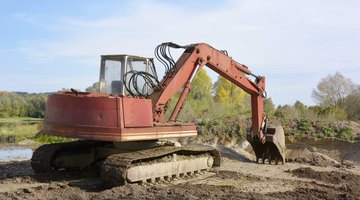What Is the Difference Between Excavating & Trenching?
Excavating and trenching both describe removing earth to create man-made open holes in the ground. According to the U.S. Occupational Safety and Health Administration, the shape and depth of the hole determines whether the hole is an excavation or a trench.

Any major excavation or trenching job is dangerous and is best left to a professional crew.
The Difference Defined
According to OSHA, an excavation is a cavity in the surface of the ground created by deliberate human action that removes earth. An excavation can be of any size or shape. A trench, says OSHA, is a specific type of excavation, a human-made narrow surface cavity that is deeper than it is wide and is less than 15 feet wide. A trench, therefore, is an excavation, but an excavation is not necessarily a trench. The term trench normally is applied to long, narrow surface cavities such as those dug to install underground utility lines, plumbing or foundation footings. Excavating is the act of digging a hole in the ground, says OSHA, while trenching is the act of digging an elongated narrow excavation.
Tools of the Trade
Hand tools for trenching include shovels and hoes with long, narrow blades for digging trenches up to 6 inches wide and less than 2 feet deep. Power trenchers come in walk-behind and ride-on models. Most employ a digging blade that resembles a giant chainsaw. For excavating on a small scale, standard shovels and other hand digging tools may suffice. Larger excavation jobs may use tractor-mounted backhoes with dirt-scooping buckets on the ends of articulated booms. Excavation on an even larger scale may use self-propelled crawler-type machine a with large buckets that can move many tons of earth at once on a swiveling, telescoping boom.
The Drip Cap
- Excavating and trenching both describe removing earth to create man-made open holes in the ground.
- Any major excavation or trenching job is dangerous and is best left to a professional crew.
- A trench, says OSHA, is a specific type of excavation, a human-made narrow surface cavity that is deeper than it is wide and is less than 15 feet wide.
- Larger excavation jobs may use tractor-mounted backhoes with dirt-scooping buckets on the ends of articulated booms.
References
Writer Bio
Herb Kirchhoff has more than three decades of hands-on experience as an avid garden hobbyist and home handyman. Since retiring from the news business in 2008, Kirchhoff takes care of a 12-acre rural Michigan lakefront property and applies his experience to his vegetable and flower gardens and home repair and renovation projects.
Photo Credits
- Schlegelfotos/iStock/Getty Images
- Schlegelfotos/iStock/Getty Images
More Articles



